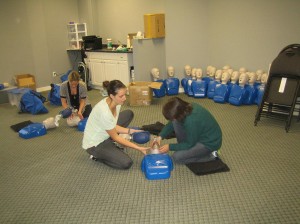How do children get heart attacks?

Children rarely get heart attacks become of lifestyle-related risk factors (as is most common with adults). When very young children like infants and toddlers get heart attacks, it is most likely caused by a respiratory condition or respiratory failure. Respiratory problems are very common in children because of their immature respiratory system and weaker immune system – respiratory is typically the end point if an infection or congenital problem is not managed adequately. When cardiac arrest is caused by respiratory failure, it is called an asphyxial arrest. The stress from respiratory failure causes the heart to beat erratically (tachycardia) and eventually stop.
Intubation
Intubation is one of the routine medical procedures performed before giving CPR. It is used to give a clear path of ventilation from the mouth to the lungs, ensuring that the victim is being ventilated adequately. Only health care providers who are trained in pediatric intubation can intubate a patient during PALS rescue. The equipment used during intubation are anesthetic spray, endortracheal tube (the correct french for the age of the child), and a laryngoscope. The following can be assessed in order to verify the placement of the tube:
- Equal, bilateral chest movement
- Equal breath sounds over right and left lung fields
- No gastric insufflation
- Presence of exhaled CO2
- Improving O2 saturation of blood)
Other methods of verification include a chest x-ray (once the patient has been stabilized) or through direct larnygoscopy.
Giving CPR to children
Giving CPR to small and young children is a little different from giving CPR to an adult. Instead of using two hands to compress the chest, at most, only one hand is used. Compression depth is shallower, at approximately 1.5 inches. For infants, only two fingers are used (either two thumbs with hands wrapped around the chest or the pointer and middle fingers of one hand). The chest should be compressed by 1/3 of its anterior-posterior diameter. Compression: ventilation ratio is the same as adults at 30:2.
The PALS CPR course
Our Pediatric Advanced Life Support (PALS) training course is long, taking two days to complete (similar to the ACLS CPR course). It runs for a total of 14 hours, over several sessions. Re-certification is also offered for this program, taking a short 6 hours and 20 minutes or 8 hours and 20 minutes session (please remember to renew your CPR training credential before it expires after 2 years). The 2 hour difference accounts for the stations or lessons that are optional and the trainee can choose not to take.
The PALS program will cover the same structure used in ACLS (Advanced Cardiac Life Support) training but will focus the management for pediatric cases (infants, toddlers, and younger children). Management involves the use of medication, equipment, and diagnostics in order to adequately manage cardiac arrest in children.